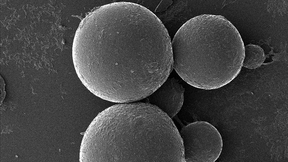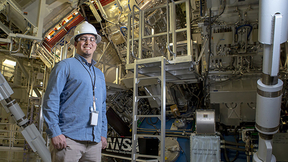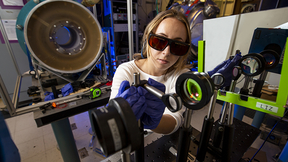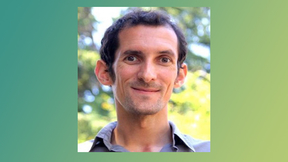Back
Physical and Life Sciences
Center Collaborates with UC San Diego to Deliver Plasma Diagnostics Course
LLNL’s HED Science Center is collaborating with the University of California (UC) San Diego, to offer a graduate-level course in diagnostics for HED plasmas. The 10-week online course will begin on March 31, 2020 and will be co-taught by two HED science experts from LLNL. HED plasma physics is a growing field, with many major laser and pulsed-power facilities around the…
LLNL researchers turn to microbe beads to increase U.S. supply of rare earth metals
To help increase the U.S. supply of rare earth elements, a Critical Materials Institute team led by Lawrence Livermore National Laboratory (LLNL) is using microbe beads to recover rare earth elements from consumer electronic waste. The team developed a scalable biosorbent material – a microbe-embedded polymer – by combining material science with microbiology. The research…
Lawrence Livermore steps into grid modernization
Lawrence Livermore National Laboratory (LLNL) will receive funding from the Department of Energy (DOE) over the next three years to strengthen, transform and improve the nation’s energy infrastructure. LLNL is the lead on three projects: Using sensors to identify faulty or aging components of the nation’s energy grid system In its first stage, this application will…
Researchers Set to Decode Biological Circuitry That Drives Peak Performance and Resilience
DARPA’s Measuring Biological Aptitude (MBA) program begins and ends with the men and women of the United States military. The program — first announced in January 2019 — centers on how service members can access the potential of their own biological systems to achieve peak results across a range of military specializations, and aims for a detailed understanding of how…
Accelerating new discoveries in nuclear physics
Three stories underground, in a Lawrence Livermore National Laboratory (LLNL) building that dates back to the 1960s, three new accelerators are rapidly expanding research capabilities. These powerful diagnostic and imaging tools enable scientists to produce and detect isotopes, explore nuclear reactions, evaluate unknown material and peer inside heavily shielded objects. …
Livermore researchers contribute to major plutonium publication
This fall, the American Nuclear Society is publishing the second edition of the Plutonium Handbook, a 4000-page, 7-volume compendium that delivers a comprehensive review of plutonium chemistry. (The first edition was published 50 years ago.) Five years in the making, this publication includes contributions from 17 Lawrence Livermore researchers, two of whom are also on the…
New ultralight gold foam shimmers in the limelight
Lawrence Livermore National Laboratory (LLNL) scientists have created the lightest gold foam to date. The new form of ultralight gold aerogel foam has applications in electronics, catalysis, sensors and energy conversion and storage. The research appears in the journal Nano Letters. It will be published in the November issue, and was selected for the…
Institute turns over a new LEAF in energy security
Lawrence Livermore National Laboratory (LLNL) has opened a center that will develop new materials for energy applications from inception to technology demonstration. The Laboratory of Energy Applications for the Future (LEAF) was formed to coordinate research efforts for energy- and environment-related technologies and capabilities. “LEAF will address crucial science and…
NIF Army veteran attends Medal of Honor ceremony
It’s been more than 10 years since John Ruiz, a mechanical designer in the National Ignition Facility’s (NIF) Facilities and Infrastructure Systems group, left the Army. But last summer, he found himself transported back to one of the most harrowing days of his Army career at the Medal of Honor ceremony for his former squad leader, Staff Sgt. David G. Bellavia. Ruiz was a…
Argon is not so noble in the Earth’s core
Lawrence Livermore National Laboratory (LLNL) scientists, in collaboration with researchers at the University of Saskatchewan (UoS), Lawrence Berkeley National Laboratory (LBNL) and The University of Chicago, have discovered that at thermodynamic conditions mimicking that of Earth’s core, argon can react with nickel, forming a stable Argon-Nickel (ArNi) compound. The LLNL…
Size matters in ion selectivity and energy storage
While ions adsorbed on carbon electrodes can vary in size and shape, when it comes to selectivity and energy storage, size really does matter. In an effort to boost energy storage and water desalination technologies, Lawrence Livermore National Laboratory (LLNL) scientists found that capacitive performance and ion selectivity of porous carbons is controlled by a complex…
NIH looks to Lab to help develop chlamydia vaccine
A cooperative research center that aims to develop vaccines for chlamydia has been established by the National Institutes of Health at Lawrence Livermore National Laboratory (LLNL). The new center, to be funded under a five-year, $10.1 million grant from the National Institute of Allergy and Infectious Diseases (NIAID), will be a three-way partnership between LLNL and…
Nuclear impulse could deflect massive asteroid
An interagency team of researchers led by Lawrence Livermore National Laboratory (LLNL) has completed the first ever in-depth investigation into how an asteroid would respond to a nuclear deflection attempt. The research was published online in Acta Astronautica and will appear in print in early 2020. The focus of the investigation was 101955 Bennu, a massive asteroid that…
Summer scholar reels in ‘STRIPED FISH’ for NIF
In high school, Liz Grace thought physics was boring and instead considered studying psychology or music. But then a college professor inspired Grace to see the wonders of physics. Today, as a National Ignition Facility (NIF) & Photon Science Summer Scholar, she’s helping to design and build a diagnostic instrument that could become a revolutionary measurement tool for…
Volcanic ash sparks new discovery
Fort Lauderdale, Fla.— Imagine you’re getting ready to fly to your favorite vacation destination when suddenly a volcano erupts, sending massive amounts of ash into the atmosphere, and forcing the cancellation of your flight. That’s exactly what happened in April 2010 when Eyjafjallajokull, a volcano in Iceland, erupted and disrupted air travel in Europe for six days. …
Unexamined lunar rocks indicate early bombardment
A team of Lawrence Livermore National Laboratory (LLNL) scientists has challenged the long-standing theory that the moon experienced a period of intense meteorite bombardment about 3.8 billion years ago, when the first forms of life appeared on Earth. This theory is known as the Late Heavy Bombardment and is thought to have resulted from disturbance of the asteroid belt…
PLS wraps up summer student programs
Approximately 1000 students came to the Laboratory this summer to engage in work-study employment in science, technology, engineering, mathematics, and administrative fields. PLS hosted a number of these students through its summer student programs (described below). Nuclear science and security The Glenn T. Seaborg Institute hosted 12 students this summer, including 8…
Application Period Opens for HEDS Postdoctoral Fellowship at LLNL
The HED Science Center is offering a highly competitive, two-year postdoctoral position at LLNL. The fellowship is open to researchers working in all HED-related disciplines. Fellows are free to pursue their own research agenda under the guidance of a senior staff scientist who serves as a mentor.
Six Lawrence Livermore researchers named 2019 fellows of the American Physical Society
Six Lawrence Livermore National Laboratory (LLNL) scientists have been selected as 2019 fellows of the American Physical Society (APS). The new fellows represent a selection of physics expertise, ranging from computational physics and shock compression of condensed matter to instrument and measurement science. APS fellowships are awarded after extensive review and are…
Center Offers Short Course on Laser-Plasma Interactions
The High Energy Density Science (HEDS) will offer a three-week course during November 2019, which will explore the principles of laser-plasma interactions that are relevant to HED physics, with a focus on unmagnetized plasmas. Pierre Michel, an LLNL expert in plasma physics, will teach the course on-site at LLNL, and his recorded lectures will be available through the HEDS…

























